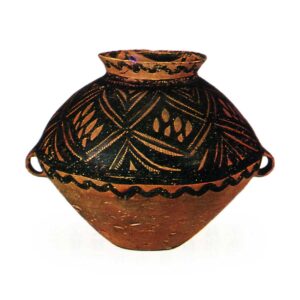
This type of unglazed earthenware with red or black colored patterns on the surface began in western Iran, northeastern Iraq, and Egypt during the Neolithic Age, and flourished from the Mediterranean Sea to the Black Sea coast and Iran during the Bronze Age. In the New Continent, it was practiced until the 15th or 6th century. The first discovery of colored ceramics in China was made by J. G. Anderson in 1923 at Yangshao Village, Henan Province, Henan Province. It was only natural that Anderson, who had learned of the flourishing of colored ceramics in the Orient, set out on a research trip upstream along the Yellow River to Gansu Province in the west, in search of a route for their spread to China. In Gansu Province, Anderson discovered and investigated a large number of colored pottery and its remains, and established the so-called “Six Gansu Periods” of Qijia, Shao, Maban, Xindian, Terakubo, and Shajing Periods. The active investigation of sites following the new construction after liberation led to the discovery of many sites, including the Xi’an Hampo site, which expanded the distribution area of the culture with colored ceramics, but at the same time, the culture was not the same in Henan, Shaanxi, and Gansu, and there were regional differences in culture. At the same time, it has become clear that the culture is not the same in Henan, Shaanxi, and Gansu regions, and that there are regional differences. In particular, the stratigraphic relationships of the painted ceramics in Gansu Province are more recent than those in Zhongyuan, and Anderson’s “Six Periods of Gansu” has had to be revised. The molding of the painted wares was done by hand, but some of the small wares were directly shaped. There are two types of clay used for the clay body: good-quality clay and clay mixed with sand. There are two types of kilns for firing this pottery: pit-type and side-hole type. The pit-type kilns have a chamber directly above the burning chamber, while the side-hole type kilns are built so that the fire rises into the chamber through two or three fire trails from the side. Both types of kiln chambers are less than one meter in diameter and have an open top, making them very primitive kilns. The kiln chamber is open at the top, making it a very primitive kiln. Of course, the fired earthenware is red pottery. The decorated vessels include bowls, trays, and pots made of red earthenware of high quality clay, sometimes painted in black or red and sometimes covered with white slip and decorated with patterns. The most common patterns are geometric designs and animal shapes, with some patterns depicting birds, frogs, fish, and other forms. For example, the painted ceramics of the Liaodong Peninsula’s Changzih fossa, after firing, are painted with geometric patterns in red and white mud paint.


